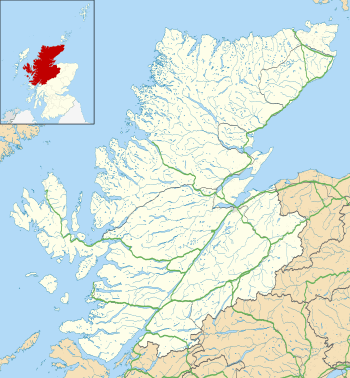Avoch
Avoch (/ˈɒx/ (![]()
Avoch
| |
|---|---|
 Avoch Location within the Highland council area | |
| Population | 891 [1] (2001 census) est. 1,000[2] (2006) |
| OS grid reference | NH699553 |
| Council area | |
| Country | Scotland |
| Sovereign state | United Kingdom |
| Post town | AVOCH |
| Postcode district | IV9 8xx |
| Dialling code | 01381 62 |
| Police | Scotland |
| Fire | Scottish |
| Ambulance | Scottish |
| UK Parliament | |
| Scottish Parliament | |


History
Origins
Ormond Castle or Avoch Castle was a stronghold built on the site and served as a royal castle to William the Lion; passed on to the Morays of Petty then Archibald the Grim, Lord of Galloway, upon his marriage to Joanna de Moravia in 1362. Descendants of Archibald, were to take the title of Earl of Ormonde from the castle. Legend has it that the village was founded by survivors of the Spanish Armada in 1588.[4][5][6][7]
Estate owners
Avoch was in the control of David Chalmers, Lord Ormond from 1560/61 but he forfeited his castle and control of Avoch in 1568 when he was exiled due to his part in assisting the escape of Mary Queen of Scots. The castle and village then passed to Andrew Munro of Milntown.[8] In the late 16th century the Munro of Pittonachy family held the estate of Pittonachy in the parish until Hugh Munro, III of Pittonachy (d.1670) sold it. It then became a property of the Mackenzies who renamed it Rosehaugh.[9][10] George Mackenzie of Rosehaugh was the first of his family to hold the estate. He was succeeded by his son, also called George Mackenzie, who left an only daughter who died without issue and thus the Mackenzie of Rosehaugh branch became extinct in the male line.[11] In 1688, the estate was purchased from Mackenzie of Rosehaugh by Sir Kenneth Mackenzie, IV of Scatwell, a family originally from the parish of Contin. Kenneth's son, Roderick Mackenzie, built a new mansion called Rosehaugh House, although in Alexander Mackenzie's 19th century history it was still referred to by the old Munro name of "Pittonachty" (Pittonachy).[12] This mansion was demolished in 1959.[13][14]
Sir Alexander Mackenzie
Intrepid Scottish-Canadian explorer Sir Alexander Mackenzie, the first European to explore the great Canadian river now known as the Mackenzie River, crossing North America twice, to the Arctic Ocean in 1789 and Pacific Ocean in 1793, retired to Avoch in 1812 where he died in 1820 and was buried in the old Avoch Parish churchyard.
Culture
Craigie Well at Avoch on the Black Isle has offerings of both coins and clouties. Rags, wool and human hair were also used as charms against sorcery, and as tokens of penance and fulfilment of a vow (Sharp 1998).
Industry
Much of Avoch's wealth has come from its fishing industry, and it remains a significant contributor to the village economy, with several large fishing boats owned or crewed from Avoch and an active fishermen's co-operative based there. The harbour is no longer used by the larger boats for landing but is used by leisure craft and boats taking visitors to see the dolphins in the inner Moray Firth at Chanonry Point. In addition to the fishing industry, commuting to Inverness and tourism provide income to the village. Lazy Corner, named for the youngsters who gathered there to pass the time, has been moved by the road widening in the Eighties, and spruced up by a sculpture intended to add character to the village. It is still a gathering place.
See also
References
- "Comparative Population Profile: Avoch Locality". Scotland's Census Results Online. 29 April 2001. Archived from the original on 19 May 2011. Retrieved 31 August 2008.
- "Archived copy". Archived from the original on 30 September 2008. Retrieved 31 January 2010.CS1 maint: archived copy as title (link)
- Microsoft; Nokia (23 March 2017). "Avoch" (Map). Bing Maps. Microsoft. Retrieved 23 March 2017.
- Munro, David M (2006). Scotland: An Encyclopedia of Places & Landscapes. HarperCollins. p. 39. Retrieved 3 May 2020.
- Fisher, Stuart (2012). Rivers of Britain: Estuaries, Tideways, Havens, Lochs, Firths and Kyles. A & C Black. p. 125. Retrieved 3 May 2020.
- Lindsay, Maurice (1980). Lowland Scottish Villages. R. Hale. p. 163. Retrieved 3 May 2020.
- Mckenzie, Steven (22 November 2007). "Drugs in 'Spanish Armada' village". BBC News Online. Retrieved 5 May 2020.
- ODNB: David Chambers, Lord Ormond
- Mackenzie, Alexander (1898). History of the Munros of Fowlis With Genealogies of the Principal Families of the Name: to which are added those of Lexington and New England. Inverness: A. & W, Mackenzie. pp. 503-508. Retrieved 6 May 2020.
- Watson, John William (1904). "Avoch". Place Names of Ross and Cromarty. Inverness: The Northern Counties Printing and Publishing Company. p. 132. Retrieved 10 May 2020.
- Mackenzie, Alexander (1894). History of the Clan Mackenzie. With Genealogies of the Principal Families of the Name. Inverness: A. & W, Mackenzie. pp. 278-279. Retrieved 6 May 2020.
- Mackenzie, Alexander (1894). History of the Clan Mackenzie. With Genealogies of the Principal Families of the Name. Inverness: A. & W, Mackenzie. pp. 425-426. Retrieved 6 May 2020.
Pittonachty
- "Rosehaugh House". Canmore. Retrieved 6 May 2020.
- "Rosehaugh". Historic Environment Scotland. Retrieved 6 May 2020.
External links
| Wikimedia Commons has media related to Avoch. |
- Lamb, W. Kaye (1983). "Mackenzie, Sir Alexander". In Halpenny, Francess G (ed.). Dictionary of Canadian Biography. V (1801–1820) (online ed.). University of Toronto Press.